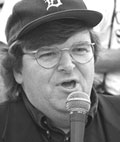By Inter-Press Service

‘Bowling for Columbine’ takes aim at America’s obsessions
On the same day in April 1999 that the United States conducted its most intense bombing of Serb positions in Kosovo, two teenagers shot to death 13 others and then killed themselves at Columbine High School in Colorado. But first they went bowling.
Such ironic juxtapositions are the crosshairs through which Michael Moore, comedic writer-director-narrator of the film “Bowling for Columbine,” takes aim at the question: What makes the United States the world’s leader in peacetime gun killings?
Over the course of two hours of a film that is at once engaging and glib, sincere and contrived, Moore attempts a scattershot explanation through a series of real-life vignettes.
In the opening scenes, he visits a bank that advertises an odd gift for new customers, opens an account, and walks out with a brand new rifle. Then he stops in at a barbershop for a haircut and some ammunition.
The bullets that killed the Columbine students, discloses Moore–also the author of the best-selling “Stupid White Men,” a rambunctious, hard-hitting critique of the U.S. political elite–were bought for 17 cents each from a K-mart shop.
In a characteristic maneuver, Moore persuades two Columbine students with bullets still embedded in their bodies to confront company officials, who then volunteer to stop selling ammunition. “Wow,” an apparently flabbergasted Moore exclaims, as if to say to his audience, “look what I did” but also, “look what you can do.”
Early on, he points out that Canada has a much lower murder rate, despite gun-ownership figures similar to those of the United States.
Determined to explore what makes the U.S. citizenry trigger-happy, Moore canvasses a paramilitary group, the shooting victims’ families, television producers and executives at the Lockheed Martin company, which builds missiles and employs 5,000 people near the Columbine school. Moore suggests that the Columbine shooters might have concluded killing was all right since their parents built missiles for a living. A Lockheed spokesman counters that the weapons are made to kill people overseas, not at home.
The film includes an argument that the United States was born in fear and continues to be driven–at home and in foreign policy–by dread.
“The very first sentence you learn about U.S. history as a child is ‘The Pilgrims came to America because they were afraid of being persecuted,’ ” says the invisible narrator of the brief cartoon inlaid into Moore’s film by the maker of the “South Park” TV series.
“They encounter the Indians and are afraid of them, so they kill them; then they start becoming afraid of each other and start seeing witches and burn them; then they win the revolution, but they’re afraid the British are going to come back. So someone writes the Second Amendment that says ‘Let’s keep our guns because the Brits could come back.’ “
“From the war in 1861, the slave population grew from 700,000 to 4 million. In parts of the rural South, Blacks outnumbered Whites by a three-to-one margin and there were a lot of slave rebellions. So in 1836, Samuel Colt invented the six-shooter.”
The slave rebellions are gone and crime has fallen to rather dull levels, as Moore, an expansive and slow-moving White man, demonstrates by taking an uneventful walk through a verdant South Central Los Angeles that bears no resemblance to its reputation for gangland mayhem.
Moore argues that much violence committed by U.S. civilians is based on paranoia stoked by TV programs such as the popular cable “reality” show “Cops” and newscasts with an “if it bleeds, it leads” mentality and often racist subtext.
He rolls out TV news headlines to demonstrate media obsession with threats, from gang warfare to “Africanized” killer bees (described as more aggressive and having bigger body parts than their “European” counterparts).
Marilyn Manson, the Gothic rocker that parents and politicians often scapegoat because his music videos contain ghoulish imagery, argues that fear is a fuel for late capitalism, since it goads people to consume to soothe their anxieties.
“South Park” creator and Columbine alumnus Matt Stone suggests the high school suicide killers snapped under relentless pressure from humorless teachers, who advance their own careers by scaring better test scores out of their pupils with the ominous claim that every minuscule decision made in school could have apocalyptic consequences for the rest of their lives.
Police officials and prosecutors add careful reasoning that contrasts with the shrill law-enforcement voices commonly heard on TV. The causes of violent crime, they say, includes cultural anxiety and welfare policies that force poor single mothers into minimum-wage jobs far from their children.
And then there is ignorance: James Nichols, who unlike his brother Terry escaped legal culpability in the deaths of 168 people in the 1995 Oklahoma City bombing, tells Moore that U.S. citizens have a duty to arm themselves in case they must overthrow an oppressive government.
Did not India’s Mohandas K. Gandhi do just that to the British Empire by non-violent means, Moore asks. “I’m not aware of that,” Nichols replies.
The film’s denoucement comes when Moore, a lifetime member of the National Rifle Association, confronts the pro-gun group’s president, actor Charlton Heston (whose playing in movies as “Moses,” and in “Planet of the Apes”), at the latter’s California home.
In a few minutes of signature celebrity-baiting, Moore gets Heston to refuse to apologize for holding gun rallies where children had recently been shot dead; to blame gun violence on the multi-ethnicity of U.S. society; and to walk away from the camera, Moses with a simian gait.












